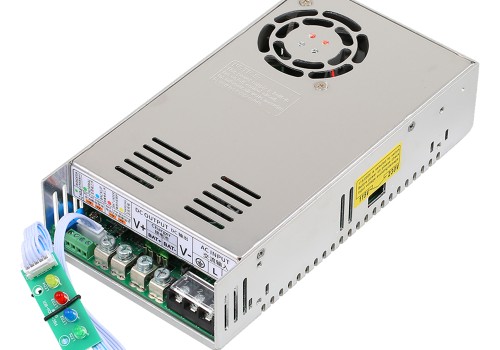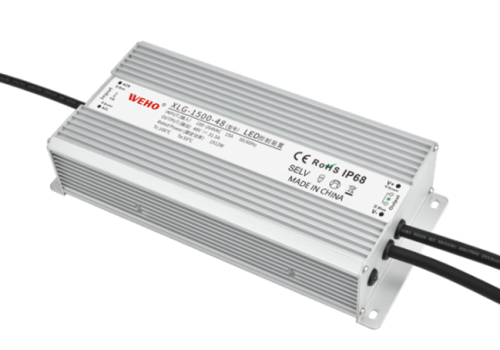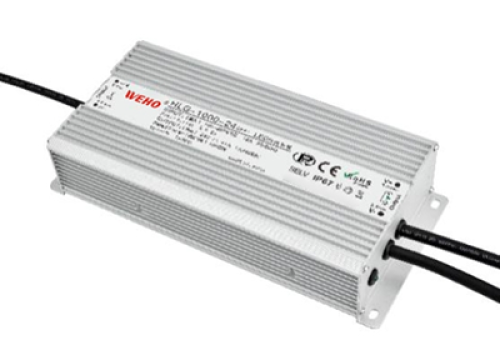Choosing the right power supply unit (PSU) is critical for the performance, safety, and longevity of any electronic system. The two most common types you’ll encounter are open frame and enclosed power supplies. While they both perform the same core function—converting AC power to DC power—their design, application, and protective features are vastly different.
Understanding these differences is key to making an informed decision that meets the specific requirements of your project.
What is an Open Frame Power Supply?
An open frame power supply is a PSU without a protective outer casing. It consists of the bare circuit board, components, and heat sinks, all mounted on a chassis or PCB. This design makes it a compact and cost-effective option, ideal for integration directly into a larger system or device.
Think of it as the raw “engine” of a power system. Because it lacks an enclosure, it relies on the host device’s chassis for mechanical support and protection from environmental factors.
What is an Enclosed Power Supply?
An enclosed power supply, also known as a cased or boxed power supply, is a PSU housed within a metal or plastic enclosure. This casing provides mechanical protection for the internal components, helps with heat dissipation, and shields the unit from dust, moisture, and accidental contact.
Commonly found in desktop computers and industrial equipment, enclosed PSUs are designed as standalone, “plug-and-play” units that can be mounted easily and safely.
Learn More: Guide to Choosing the Perfect Security Power Supply
Key Differences: Open Frame vs. Enclosed Power Supplies
The choice between these two types often comes down to five critical factors: design, safety, thermal management, efficiency, and cost.
| Feature | Open Frame Power Supply | Enclosed Power Supply |
| Design | Flexible, compact, customizable. Requires system integration for protection. | Standardized, robust, standalone unit. Simplifies installation. |
| Safety | Exposed components; user safety relies on the final product’s enclosure. | Built-in safety barrier; certified as a standalone unit. |
| Heat Dissipation | Relies on the host system’s cooling (convection/forced air). | Case acts as a heatsink; often includes an integrated fan for active cooling. |
| Reliability | Dependent on the thermal and mechanical design of the final system. | High reliability due to protected, controlled internal environment. |
| Cost | Lower unit cost; total project cost may increase with custom design needs. | Higher initial unit cost; lowers overall project design and engineering costs. |
1. Power Supply Design
- Open Frame: The design is highly flexible and can be customized to fit tight spaces. However, it requires careful consideration of the final product’s enclosure to ensure proper mounting and air circulation. Its exposed nature makes it unsuitable for environments where it might be handled by users.
- Enclosed: The design is standardized and robust. The pre-built case simplifies installation and provides a complete, self-contained solution. This makes it a great choice for applications where the power supply is a separate component rather than an integrated part of a larger board.
2. Safety & Compliance
Safety is a primary concern. The key difference here is the level of inherent protection each design provides.
- Open Frame: As the name suggests, the components are exposed. This poses a risk of electric shock and requires the end product to provide its own safety enclosure and isolation. Compliance with safety standards like UL, CE, and TUV is achieved for the entire system, not just the power supply itself.
- Enclosed: The case acts as a primary safety barrier, protecting users from live components. It is typically certified to meet international safety standards as a standalone unit, simplifying the safety and compliance process for the final product.
3. Heat Dissipation in Power Supplies
Efficient thermal management is crucial for reliability.
- Open Frame: Heat dissipation is often managed by relying on the host system’s cooling strategy, whether that’s natural convection or forced air from a fan. The exposed design allows for direct airflow over components, which can be an advantage if the system has an effective cooling fan.
- Enclosed: The metal case often doubles as a heat sink, transferring heat from the internal components to the outside. Many enclosed units also feature an integrated fan for active cooling, making them suitable for higher power applications or use in sealed environments.
4. Power Supply Efficiency & Reliability
Both types can be highly efficient, but the form factor can influence long-term reliability.
- Open Frame: When properly integrated into a well-designed system, an open frame unit can be very reliable. Its reliability is tied directly to the thermal and mechanical design of the final product.
- Enclosed: The self-contained, often fan-cooled, design provides a controlled environment for the components, which can contribute to higher reliability and a longer operational life. The enclosed case also protects against dust and moisture, which can degrade performance over time.
5. Cost Considerations
- Open Frame: Generally more cost-effective at a unit level due to the lack of an enclosure. However, the total system cost might increase if you need to design a custom enclosure and thermal management solution.
- Enclosed: Higher initial cost per unit due to the case and often an integrated fan. This is balanced by the reduced design and engineering costs for the final product, as the power supply is a pre-certified, ready-to-use component.
Learn More: Switching Power Supply vs AC Adapter
Learn More: AC vs DC Power Supplies
Learn More: Linear vs Switching Power Supply
How to Choose the Right Power Supply for Your Application
Choosing between open frame and enclosed power supplies depends on your specific needs.
- Choose an Enclosed Power Supply if:
- Safety is paramount: The power supply will be a standalone unit or accessible to end-users.
- You need a simple, ready-to-install solution: No need to design a custom enclosure or cooling system.
- The environment is harsh: The unit needs protection from dust, moisture, or physical impact.
- You require high power and reliability: The built-in cooling and robust casing are ideal for demanding industrial applications.
- Choose an Open Frame Power Supply if:
- Space is limited: You need a compact solution that can be integrated directly onto a board.
- Cost is a primary driver: The unit price is lower, and you can leverage an existing system enclosure.
- You are a product designer: You have control over the entire system’s thermal and mechanical design, and the final product will provide the necessary protection.
Learn More: How to Choose a WeHo Power Supply?
Future Trends in Power Supply Design
The power supply industry is evolving with a focus on higher efficiency, smaller footprints, and smarter functionality. Trends include:
- Higher Power Density: More power in a smaller package.
- Digital Control: The use of microcontrollers for greater efficiency and programmability.
- Enhanced Thermal Management: New materials and designs for better heat dissipation.
- Modular and Customizable Designs: A growing demand for PSUs that can be easily adapted to specific project requirements.
Learn More: What is the High Voltage Switching Power Supply Design?
FAQs
What is the main difference between open frame and enclosed power supplies?
The main difference is the presence of an external casing. Open frame PSUs are bare circuit boards, while enclosed PSUs are housed in a protective case.
Which is better for industrial applications?
Enclosed power supplies are generally better for industrial applications. Their robust casings protect against dust, moisture, and vibration, and their self-contained cooling systems ensure reliability in demanding environments.
Are open frame power supplies safe?
Yes, open frame PSUs are safe when they are correctly integrated into a final product that provides a protective enclosure and meets all necessary safety standards. They are not intended for use as standalone units.
How do I know if I need a compact or enclosed design?
If your project has limited space and you can integrate the PSU into your device’s existing enclosure, a compact, open frame design is a great choice. If the PSU needs to be a standalone, protected component, an enclosed design is best.
Can I customize an AC-DC power supply for my project?
Yes. Many manufacturers offer customization services for both open frame and enclosed AC-DC power supplies. This allows you to tailor the output voltage, current, and form factor to meet the unique needs of your application.
Conclusion
Whether you choose an open frame or enclosed power supply, the key is to understand the specific needs of your application. Each type offers distinct advantages in terms of cost, space, safety, and performance. By carefully evaluating these factors, you can select a PSU that provides a stable, reliable, and efficient power solution.
At Weho, we offer a wide range of high-quality open frame and enclosed power supplies, along with expert consultation to help you find the perfect fit for your next project.










